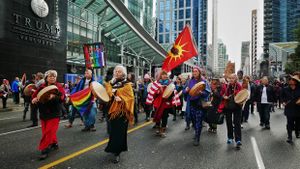2017 Women's March

The Women’s March took place on January 21, 2017 throughout the world. It was initially planned as a protest in Washington, DC to spread the message of women’s rights as human rights, specifically to the new Trump administration. It rose in popularity, gaining attention worldwide with protests scheduled in most major cities.
The Women’s March served as a platform for individuals wanting to advocate for legislative change regarding women’s rights, reproductive rights, LGBTQIA rights, gender equality, racial equality, immigration reform, worker rights, healthcare reform and environmental protection. [1]
Though globally this resistance movement saw an estimated 4 million (including celebrities and politicians) march in solidarity, criticisms arose over its inclusivity and future.
Critical Response
Criticisms existed much before the march gained in popularity. Originally titled the ‘Million Woman March’, the public questioned if this was an appropriate title for the cause as it occupied the same name as the iconic 1997 Pennsylvania march in which African-American women marched in protest of their struggles[2].
Further to the name, comments criticizing and questioning the three white feminists organizing the march and their ability to truly grasp the experiences and struggles of systemically marginalized women and sufficiently formulate an intersectional response. This led to the diversification of both their team and media messaging (i.e. promotional posters featuring women of colour)[3].
A libertarian writer, Shikha Dalmia, characterized the march as ‘shaping up to be a feel-good exercise in search of a cause.” While the intent and inspiration may have been there, doubts as to whether or not momentum could continue and if systemic change could actually happen persisted. [4]

While the women’s march was intended to represent unity, some academics wondered if this was a movement accessible to all. Those that have attempted to organize and mobilize the masses for issues critical to marginalized communities have seen little success or positive responses, especially those of colour. This brings with it long standing arguments regarding the privilege white women and white bodies have in taking up space, something that can be easily contrasted to responses Black Lives Matter have had by both the public, media and the justice system. Because of previous reception, some people of colour did not feel comfortable participating in such a march, be that because of fear or principle. [5]
Vancouver Chapter
The Vancouver Women’s March gathered at Jack Poole Plaza and looped around the Trump tower and US embassy, with tens of thousands of individuals partaking and heavy media presence.[6] While the Vancouver chapter of the women’s march stood in solidarity with those about to face President Trump’s reign, it was also served as an eye-opening showcase of what kind of support (in numbers) Vancouver can produce.

This begs the questions of how sincere the response was and what the march could mean for local communities, particularly Indigenous women. The February 14th Women’s Memorial March has been taking place in Vancouver for the last 27 years.[7] It has yet to receive a response as large as the women’s march despite it fighting against violence against Indigenous women, an issue concerning local and national communities. This could be further analyzed on who is a ‘worthy’ victim and why certain social movements garner large attention while others do not. Missing and Murdered Indigenous Women is a sad and unacceptable epidemic that has received little public outrage or engagement.
In addition to contrasts that can be made to local activist movements, the Vancouver chapter also received some heat following some controversy with Black Lives Matter-Vancouver. Organizers of the Vancouver march neglected to formally include BLM-V and censored responses after being called out. [8]
The Future
The march brought attention to injustices facing marginalized communities and the outpouring support served its purpose. However, many have argued that this was just a temporary fix to a much larger systemic issue. For change to truly occur, persistence and momentum is key. Organizers of the women’s march have attempted to keep this going through the introduction of various key issues and their '10 actions for the first 100 days' [9]but nothing has quite hit the same mark.
Engagement and strategy also begins at local communities, here is where we see how grassroots activists can make a difference to policy and legislation. But the women’s march also showed the world the power of mass and social media. By personalizing the issues, organizers were able to connect and reach out to many more individuals deeming the protest a success. However, when examining issues facing people of colour, the disabled, LGBTQIA, etc it is not personalized, nor should it have to be. The problem in this case needs to be framed as an issue that concerns the progress of humanity and reminds the privileged of the benefits of promoting equity.
References
- ↑ https://www.womensmarch.com/mission/
- ↑ http://edition.cnn.com/US/9710/25/million.woman.march2/index.html?_s=PM:US
- ↑ http://nypost.com/2017/01/05/the-womens-march-on-washington-is-becoming-a-joke/
- ↑ http://theweek.com/articles/667163/why-womens-march-washington-already-failed
- ↑ https://www.bostonglobe.com/lifestyle/2017/01/26/was-women-march-just-another-display-white-privilege-some-think/YU3ZE4ajyX2faKZ5U7XhkJ/story.html
- ↑ http://www.cbc.ca/news/canada/british-columbia/thousands-gather-in-vancouver-to-support-u-s-women-s-march-1.3946647
- ↑ https://womensmemorialmarch.wordpress.com/
- ↑ http://www.straight.com/news/859366/black-lives-matter-vancouver-await-response-womens-march-organizers-following-erasure
- ↑ http://www.freep.com/story/news/2017/01/22/10-actions-womens-march/96935642/